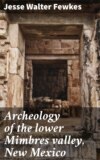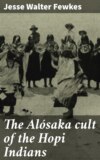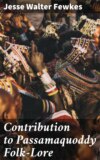Kitabı oku: «The Winter Solstice Altars at Hano Pueblo», sayfa 2
Tewa Legends
According to one authority (Kalakwai) the route of migration of the Hano clans from their ancient home, Tcewadi, led them first to Jemesi (Jemez), where they rested a year. From Jemesi they went to Orpinpo or Pawikpa ("Duck water"). Thence they proceeded to Kepo, or Bear spring, the present Fort Wingate, and from this place they continued to the site of Fort Defiance, thence to Wukopakabi or Pueblo Ganado. Continuing their migration they entered Puñci, or Keam's canyon, and traversing its entire length, arrived at Isba, or Coyote spring, near the present trail of the East Mesa, where they built their pueblo. This settlement (Kohti) was along the foot-hills to the left of the spring, near a large yellow rock or cliff called Sikyaowatcomo ("Yellow-rock mound"). There they lived for some time, as the debris and ground-plan of their building attest. Their pueblo was a large one, and it was conveniently near a spring called Uñba, now filled up, and Isba, still used by the Hano people.
Shortly after their arrival Ute warriors made a new foray on the Hopi pueblos, and swarmed into the valley north of Wala,11 capturing many sheep which they drove to the hills north of the mesa.12 The Tewa attacked them at that place, and the Ute warriors killed all the sheep which they had captured, making a protecting rampart of their carcasses. On this account the place is now called Sikwitukwi ("Meat pinnacle"). The Tewa killed all but two of their opponents who were taken captives and sent home with the message that the Bears had come, and if any of their tribe ever returned as hostiles they would all be killed. From that time Ute invasions ceased.
According to another good authority in Tewa lore, the Asa people left "Kaëkibi," near Abiquiu, in northern New Mexico, about the time the other Tewa left Tcewadi They traveled together rapidly for some time, but separated at Laguna, the Asa taking the southern route, via Zuñi. The Tewa clans arrived first (?) at Tusayan and waited for the Asa in the sand-hills near Isba. Both groups, according to this authority, took part in the Ute fight at Sikwitukwi, and when they returned the village chief of Walpi gave the Asa people for their habitation that portion of the mesa top northeast of the Tewakiva, while the present site of Hano was assigned to the Tewa clans. During a famine the Asa moved to Tübka (Canyon Tsegi, or "Chelly"), where they planted the peach trees that are still to be seen. The ruined walls east of Hano are a remnant of the pueblo abandoned by them. The Asa intermarried with the Navaho and lost their language. When they returned to the East Mesa the Hopi assigned to them for their houses that part of Walpi at the head of the stairway trail on condition that they would defend it.13
In view of the tenacity with which the women of Hano have clung to their language, even when married to Hopi men, it seems strange that the Asa lost their native dialect during the short time they lived in Tsegi canyon; but the Asa men may have married Navaho women, and the Tanoan tongues become lost in that way, the Asa women being in the minority. There is such uniformity in all the legends that the Asa were Tanoan people, that we can hardly doubt their truth, whatever explanation may be given of how the Asa lost their former idiom.
In 1782 Morfi described Hano,14 under the name "Tanos," as a pueblo of one hundred and ten families, with a central plaza and streets. He noted the difference of idiom between it and Walpi. If Morfi's census be correct, the pueblo has diminished in population since his time. Since 1782 Hano has probably never been deserted, although its population has several times been considerably reduced by epidemics.
In return for their aid in driving the Ute warriors from the country, the Hopi chief gave the Tewa all the land in the two valleys on each side of the mesa, north and east of a line drawn at right angles to Wala, the Gap. This line of demarcation is recognized by the Tewa, although some of them claim that the Hopi have land-holdings in their territory. The line of division is carefully observed in the building of new houses in the foot-hills, for the Hopi families build west of the line, the Tewa people east of it.
Differences in Social Customs
A casual visitor to the East Mesa would not notice any difference between the people of Hano and those of Walpi, and in fact many Walpi men have married Tanoan women and live in their village. The difference of idiom, however, is immediately noticeable, and seems destined to persist. Almost every inhabitant of Hano speaks Hopi, but no Hopi speaks or understands Tewa. While there are Tewa men from Hano in several of the Hopi villages, where they have families, no Tewa woman lives in Walpi. This is of course due to the fact that the matriarchal system exists, and that a girl on marrying lives with her mother or with her clan, while a newly married man goes to the home of his wife's clan to live.
There are differences in marriage and mortuary customs, in the way the women wear their hair,15 and in other minor matters, but at present the great difference between the Hopi and the Tewa is in their religious ceremonials, which, next to language, are the most persistent features of their tribal life. Hano has a very limited ritual; it celebrates in August a peculiar rite known as Sumykoli, or the sun prayer-stick making, as well as the Tûñtai midwinter ceremony, the altars of which are described herein. There are also many Katcina dances which are not different from those performed at Walpi. One group of clown priests, called Paiakyamû, is characteristic of Hano. Compared with the elaborate ritual of the Hopi pueblo, that of Hano is poor; but Tewa men are members of most of the religious societies of Walpi, and some of the women take part in the basket dance (Lalakoñti) and Mamzrauti, in that village.
The following Tewa names for months are current at Hano:
January, Elo-p'o, "Wooden-cup moon"; refers to the cups, made of wood, used by the Tcukuwympkiyas in a ceremonial game.
February, Káuton-p'o, "Singing moon."
March, Yopobi-p'o, "Cactus-flower moon." The element pobi16 which is so often used in proper names among the Tewa, means flower.
April, Púñka-p'o, "Windbreak moon."
May, Señko-p'o, "To-plant-secretly moon." This refers to the planting of sweet corn in nooks and crevices, where children may not see it, for the Nimán-katcina.
June-October, nameless moons, or the same names as the five winter moons.
November, Céñi-p'o,17 "Horn moon," possibly referring to the Aaltû of the New-Fire ceremony.
December, Tûñtai-p'o, "Winter-solstice moon."







